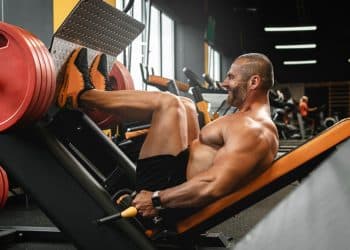When training shoulders, most people focus on the front and side delts with pressing and lateral raise exercises. However, this neglects the rear delts, which are crucial for complete shoulder development, stability, and injury prevention. A balanced training regimen that addresses all three deltoid heads is essential for maximizing shoulder strength, function, and athleticism.
As an experienced personal trainer specializing in home gym setups, I consistently integrate rear delt dumbbell exercises into my clients’ routines to enhance shoulder function and physique aesthetics.
In this article, I reveal the 10 best rear delt dumbbell exercises to work this vital but often overlooked muscle group.
Recent Updates: On May 31, 2024, Fitness Volt’s Senior Editor, Vidur Saini (American Council on Exercise-CPT), revised the exercise list and added actionable expert tips to improve the reader experience.
Level Up Your Fitness: Join our 💪 strong community in Fitness Volt Newsletter. Get daily inspiration, expert-backed workouts, nutrition tips, the latest in strength sports, and the support you need to reach your goals. Subscribe for free!
10 Best Dumbbell Rear Delt Exercises
Given below are the thirteen best dumbbell rear delt exercises:
- Seated Dumbbell Reverse Flye
- Dumbbell Side-Lying Lateral Raise
- Incline Supine Dumbbell Raise
- Standing Bent-Over Rear Delt Raise
- Renegade Row
- W Raise
- Hip Huggers
- Underhand Rear Delt Raise
- Rear Deltoid Dumbbell Swing
- Dumbbell Seated Bent-Over Rear Delt Row
1. Seated Dumbbell Reverse Flye
This Exercise:
- Target Muscle Group: Posterior deltoid
- Secondary Muscles: Medial deltoid
- Type: Hypertrophy
- Mechanics: Isolation
- Equipment: Dumbbells
- Difficulty: Intermediate
- Best Rep Range:
- Hypertrophy: 8-12
The seated bent-over dumbbell reverse fly allows you to move your delts through their natural range of motion. The seated position also helps eliminate momentum and better isolate the rear delts.
“Initiate the movement by retracting your scapulae (pulling your shoulder blades together) before moving your arms,” recommends Saini. The pre-activation maximizes rear delt engagement.
Steps:
- Sit on a bench with a pair of dumbbells in your hands. Do not use a weight that is too heavy, as you are targeting a relatively small muscle group.
- Maintaining a neutral back position, position your upper body at 45 degrees.
- With your arms slightly bent and the dumbbells at your sides, pivot from the shoulders and bring the weights up to shoulder level.
- Hold the top position for 2 seconds, then lower it under control.
Pro tip: Keep your elbows slightly flexed throughout the exercise.
Benefits of the seated dumbbell reverse flye:
- Strengthen the upper back muscles
- Improve posture
- Balance shoulder muscle development
- Reduce the risk of injury
- Enhance upper body stability
| Progression | Regression |
| Standing Dumbbell Reverse Flye (increased range of motion) | Chest-Supported Dumbbell Reverse Flye (increased stability) |
2. Dumbbell Side-Lying Lateral Raise
This Exercise:
- Target Muscle Group: Posterior deltoid
- Secondary Muscles: Medial deltoid
- Type: Hypertrophy
- Mechanics: Isolation
- Equipment: Dumbbells
- Difficulty: Intermediate
- Best Rep Range:
- Hypertrophy: 8-15
The lying dumbbell side raise allows you to work each rear delt unilaterally. This exercise has a steep learning curve, so make sure you master the movement mechanics before using heavier weights.
Saini suggests thinking about leading the movement with your elbows instead of focusing on lifting the weight. This external rotation bias enhances side delt recruitment and reduces front delt strain.
Steps:
- Lie on your side on a flat bench with your legs stacked and a dumbbell in your top hand.
- Hold the dumbbell below your lower hip while the other hand supports your head.
- Keep your elbow slightly bent and raise your arm up and away from your body.
- Raise your arm as high as possible, then slowly lower it back to the starting position.
Pro tip: Use a relatively lightweight and focus on the burn!
Benefits of the dumbbell side-lying lateral raise:
- Allows working one side at a time
- Eliminates momentum
| Progression | Regression |
| Standing Dumbbell Lateral Raise (increased core engagement) | Chest-Supported Dumbbell Reverse Flye (increased stability) |
3. Incline Supine Dumbbell Raise
This Exercise:
- Target Muscle Group: Posterior deltoid
- Secondary Muscles: Medial deltoid
- Type: Hypertrophy
- Mechanics: Isolation
- Equipment: Dumbbells
- Difficulty: Intermediate
- Best Rep Range:
- Hypertrophy: 8-15
This isolation exercise places the shoulder girdle at the ideal angle to target the rear delts.
Slightly protract your scapulae (round your shoulders forward) at the bottom of the movement to maximize posterior delt recruitment, advises Saini.
Steps:
- Lie face down on an incline bench set at 45 degrees.
- Grab a pair of dumbbells in your hands.
- Perform side lateral raises by bringing the dumbbells to the sides until they reach shoulder height.
- Hold for a second, then slowly lower as you resist gravity.
Pro tip: Focus on the isometric hold and slow eccentric portion of the rep.
Benefits of the incline supine dumbbell raise:
- Isolates the rear delts
| Progression | Regression |
| Incline Supine Cable Raise | Incline Dumbbell Y Raise (easier shoulder position) |
4. Standing Bent-Over Rear Delt Raise
This Exercise:
- Target Muscle Group: Posterior deltoid
- Secondary Muscles: Trapezius, rhomboids
- Type: Hypertrophy
- Mechanics: Isolation
- Equipment: Dumbbells
- Difficulty: Intermediate
- Best Rep Range:
- Hypertrophy: 8-12
The bent-over delt raise in a standing position allows you to isolate and work the rear delts through a full range of motion. It doesn’t require a bench, so you can do it with just a pair of dumbbells.
“Maintain a slight external rotation of your shoulders throughout the movement to ensure the rear delts are doing most of the work,” Saini says.
Steps:
- Stand with a pair of dumbbells in your hands.
- Bend over so that your torso is parallel with the floor. Be sure to maintain a neutral spine throughout the movement.
- In this position, perform a side lateral raise by bringing dumbbells out and up to shoulder height.
- Keep your elbows slightly bent but lock your arms so that the only movement is through the shoulder joint.
- Slowly lower the dumbbells to return to the start position, resisting the pull of gravity.
Pro tip: Do not swing or use momentum to get the weight up.
Benefits of the standing bent-over dumbbell raise:
- Isolates the rear delts
- No bench required
| Progression | Regression |
| Seated Bent-Over Rear Delt Raise (isolates rear delts) | Incline Rear Delt Raise |
5. Renegade Row
This Exercise:
- Target Muscle Group: Posterior deltoid
- Secondary Muscles: Latissimus dorsi
- Type: Hypertrophy
- Mechanics: Compound
- Equipment: Dumbbells
- Difficulty: Intermediate
- Best Rep Range:
- Hypertrophy: 8-12
- Strength: 1-5
The renegade row is a dynamic exercise that requires core stability and balance. Besides the rear delts, it works the lats and the front delts.
Saini prescribes pulling the elbows towards the hips instead of just lifting the dumbbell to the chest. This cue better targets the rear delts and lats.
Steps:
- Get down on the floor with a pair of dumbbells in your hands and assume a high plank position.
- With your body in a straight line and your core tight, row the right-hand dumbbell up to your rib cage.
- Lower and repeat on the opposite side.
- Alternate between sides for the recommended reps.
Pro tip: Do not round your back during this exercise.
Benefits of the renegade row:
- Improves core strength and upper body stability
- Strengthens the lats
- Develops the rear delts
| Progression | Regression |
| Renegade Row with Push-Up (increased difficulty) | Knee-Supported Renegade Row (reduced instability) |
6. W Raise
This Exercise:
- Target Muscle Group: Posterior deltoid
- Secondary Muscles: Lateral deltoid
- Type: Hypertrophy
- Mechanics: Isolation
- Equipment: Dumbbells
- Difficulty: Intermediate
- Best Rep Range:
- Hypertrophy: 8-15
The W Raise works the rotator cuffs, the shoulder muscles that help stabilize the joint. By strengthening these muscles, you can reduce the shoulder injury risk and improve overall shoulder stability and strength.
Use relatively light weights and focus on contracting and stretching the rear delts with each rep, says Saini.
Steps:
- Sit on a bench holding a pair of dumbbells in front of your body with your elbows bent.
- With a neutral spine position, lean your body forward to be at a 45-degree angle with the floor.
- Pivot from the shoulders to bring your elbows up and back so that your arms form a ‘W.’
- Hold this position for a second and then lower the dumbbells back to the start position.
Pro tip: Focus on pulling the elbows behind the midline with each rep for optimal rear delt stimulation.
Benefits of the W raise:
- Strengthens shoulder muscles
- Improves shoulder stability
- Enhances rotator cuff function
- Improves posture
| Progression | Regression |
| Bent-Over Rear Delt Raise | Incline Dumbbell W Raise (decreased resistance) |
7. Hip Huggers
This Exercise:
- Target Muscle Group: Posterior deltoid
- Secondary Muscles: Trapezius
- Type: Hypertrophy
- Mechanics: Isolation
- Equipment: Dumbbells
- Difficulty: Intermediate
- Best Rep Range:
- Hypertrophy: 8-12
You will get a great contraction in the rear delts with this exercise. Plus, it allows you to use heavier weights than most other rear delt exercises.
“The key here is to keep your torso stable at 45 degrees as you drive your elbows towards your hips and the ceiling,” said Saini.
Level Up Your Fitness: Join our 💪 strong community in Fitness Volt Newsletter. Get daily inspiration, expert-backed workouts, nutrition tips, the latest in strength sports, and the support you need to reach your goals. Subscribe for free!
Steps:
- Take a pair of heavy dumbbells and stand with them at your sides, with the palms facing inwards.
- As you rotate your hand to face forwards, bring your elbows up and back.
- Your elbows should extend back beyond your body as the dumbbells move 10–12 inches up along your torso.
- Stop the upward movement when the dumbbell is just above your navel.
- Return to the start position and repeat.
Pro tip: Do not swing your back or bend your elbows.
Benefits of hip huggers:
- Builds strength and size in the posterior delts
| Progression | Regression |
| Bent-Over Rear Delt Raise | Incline Rear Delt Raise |
8. Underhand Rear Delt Raise
This Exercise:
- Target Muscle Group: Posterior deltoid
- Secondary Muscles: Latissimus dorsi
- Type: Hypertrophy
- Mechanics: Isolation
- Equipment: Dumbbells
- Difficulty: Intermediate
- Best Rep Range:
- Hypertrophy: 8-12
The secret to engaging the posterior delts is to extend the arm behind the torso. This exercise more successfully accomplishes that than a rear delt fly.
Steps:
- Grab a dumbbell in each hand, sit on a flat bench, and position your torso at 45 degrees.
- Hold the dumbbells on your side with your palm facing forward.
- Bring the dumbbell up to your ribs by pulling your elbow back and up.
- Rotate the dumbbell as you pull the weight up so that your palm faces toward the ceiling in the top position.
- Lower and repeat.
Pro tip: Use a lightweight dumbbell and concentrate on feeling the contraction in the rear delts.
Benefits of the underhand delt raise:
- Isolate the rear delts
- Improve shoulder stability
- Enhance rotator cuff function
| Progression | Regression |
| Standing Underhand Rear Delt Raise | Incline Underhand Rear Delt Raise |
9. Rear Deltoid Dumbbell Swing
This Exercise:
- Target Muscle Group: Posterior deltoid
- Secondary Muscles: Medial deltoids
- Type: Hypertrophy
- Mechanics: Isolation
- Equipment: Dumbbells
- Difficulty: Intermediate
- Best Rep Range:
- Hypertrophy: 8-12
The rear deltoid dumbbell swing was a favorite of the late IFBB pro, John Meadows. It involves a small range of motion but does a great job of isolating the rear delts.
Focus on limiting the movement to the shoulder joint for a deep rear delt stretch, emphasizes Saini.
Steps:
- Lie face down on a 45-degree incline bench with dumbbells in your hands. Hang your arms down, letting your shoulder drop.
- Cross your feet over on the bench for added balance and support. Drop your head down.
- Without bending your elbows, move your arms out laterally about 12 inches.
- Return to the start position under control. Do not let the dumbbells touch.
- Perform high reps; 3 sets of 50 is ideal!
Pro tip: Keep your shoulders and head down throughout the movement. This will keep the focus on the rear delts rather than the traps and rhomboids.
Benefits of the lying supine rear delt flye:
- Isolate the rear delts
- Improve shoulder stability
- Enhance rotator cuff function
| Progression | Regression |
| Standing Cable Rear Delt Row (increased control) | Bent-Over Rear Delt Raise with Light Weight (focus on form) |
10. Dumbbell Seated Bent-Over Rear Delt Row
This Exercise:
- Target Muscle Group: Posterior deltoid
- Secondary Muscles: Latissimus dorsi
- Type: Hypertrophy
- Mechanics: Isolation
- Equipment: Dumbbells
- Difficulty: Intermediate
- Best Rep Range:
- Hypertrophy: 8-12
This exercise combines a bent-over row for the lats and a rear delt row for the posterior delts.
Your elbows should always align with the shoulders throughout the ROM, recommends Saini. Plus, keep your chest proud during the exercise for optimal posterior delt stimulation.
Steps:
- Sit on a bench’s end with a pair of dumbbells in your hands in an overhand grip.
- Maintaining a neutral spine, position your torso at 45 degrees.
- Pull the dumbbells directly up, bending the elbows to bring them to shoulder level.
- Lower under control.
Pro tip: Squeeze your shoulder blades together in the top position.
Benefits of the dumbbell seated rear delt bent over row:
- Isolate the middle and rear delts
- Improve shoulder stability
- Enhance rotator cuff function
| Progression | Regression |
| Single-Arm Bent-Over Dumbbell Row (increased core stability) | Incline Rear Delt Row (decreased resistance) |
Best Dumbbell Rear Delt Shoulder Workout
Rear delts are a small muscle group; you don’t need to dedicate an entire workout to training them. Performing one to two posterior deltoid exercises in a workout is sufficient to get the job done. Here is a workout you can do if you only have access to dumbbells:
| Exercise | Sets | Reps |
| Dumbbell Shoulder Press | 3 | 10-12 |
| Dumbbell Lateral Raise | 3 | 8-10 |
| Dumbbell Front Raise | 3 | 10-12 |
| Seated Dumbbell Reverse Flye | 3 | 12-15 |
| W Raise | 3 | 12-15 |
Shoulder Anatomy
The deltoid, or shoulder, muscle consists of three separate portions, or ‘heads.’ Each of these heads has its unique function and direction of movement.
The three deltoid heads are:
- Anterior (front)
- Lateral (middle)
- Posterior (rear)
The front deltoid originates on the outer half of the clavicle and inserts on an area of the upper arm bone (humerus), known as the deltoid tuberosity of the humerus. This part of the muscle is involved in the forward and upward movement of the arms.
The middle deltoid originates on the outer edge of the acromion process on the scapula and inserts on the deltoid tuberosity of the humerus, next to the front deltoid head. Its function is to raise the arms sideways.
The rear deltoid originates on the upper ridge of the scapula and inserts on the deltoid tuberosity of the humerus, right next to the lateral head. The main function of the rear delt is pulling the arm back and down. It is also involved in the external rotation of the upper arm. When your arms are by your side, the rear delt muscle fibers run diagonally from origin to insertion.
Benefits of Exercising the Rear Delts
In addition to ensuring balanced shoulder muscular development, there are important functional reasons to work the rear delts, including:
Improves shoulder stability
Strengthening the posterior deltoid helps improve shoulder stability by increasing the strength and stability of the rotator cuff muscles, which are responsible for controlling the motion of the shoulder joint.
A strong posterior deltoid also helps maintain proper alignment of the shoulder blade, which reduces the risk of shoulder impingement and other shoulder injuries. Additionally, a well-developed posterior deltoid can help counteract the forward pull of the chest muscles, which can help improve posture and prevent rounded shoulders.
Prevents muscle imbalances
Strengthening the posterior deltoid helps prevent muscle imbalances by balancing the strength of the three deltoid heads (anterior, lateral, and posterior). When the posterior deltoid is weak, the anterior and lateral deltoids can become dominant, leading to a forward tilt of the shoulders and an increased risk of shoulder impingement and other shoulder injuries.
By strengthening the posterior deltoid, you can help create a more balanced distribution of strength and stability in the shoulder region, reducing the risk of injury and promoting proper posture and movement patterns.
Enhances athletic performance
Strengthening the posterior deltoid can enhance athletic performance by improving upper body strength and power, particularly in activities involving overhead movements, such as throwing, jumping, and lifting.
A strong posterior deltoid helps improve shoulder joint stability, reducing the risk of injury and allowing for more forceful and explosive movements. Additionally, a well-developed posterior deltoid can help improve posture and overall body mechanics, making it easier to maintain proper form and technique during athletic activities.
By improving upper body strength, stability, and posture, a stronger posterior deltoid can help enhance athletic performance in a variety of sports and activities.
Improves posture
Strengthening the posterior deltoid can improve posture by countering the forward pull of the chest muscles, which can cause the shoulders to round forward and the upper back to become rounded.
When the posterior deltoid is strong, it helps to pull the shoulder blades back and upward, promoting a more upright posture and preventing rounded shoulders. A strong posterior deltoid can also help improve posture by promoting proper shoulder blade alignment and reducing the risk of shoulder impingement and other shoulder injuries.
Additionally, by improving overall upper body strength, a stronger posterior deltoid can help improve posture and overall body mechanics, reducing the risk of developing poor postural habits over time.
Reduces risk of injury
Strengthening the posterior deltoid can reduce the risk of injury by improving shoulder stability, posture, and overall upper body strength. A strong posterior deltoid helps improve stability in the shoulder joint, reducing the risk of shoulder impingement and other shoulder injuries.
By improving posture, a strong posterior deltoid can also help reduce the risk of lower back pain and other musculoskeletal problems that can arise from poor posture. Additionally, a well-developed posterior deltoid can help prevent muscle imbalances, reducing the risk of injury and promoting proper movement patterns during physical activity.
Why Use Dumbbells to Work the Rear Deltoids?
Here is why you should use dumbbells to work the rear delts:
- Unilateral training: Dumbbells allow for individualized shoulder targeting.
- Versatility: Dumbbells can be used in various exercises to target the rear deltoids.
- Adjustable weight: Dumbbells allow for easy weight adjustments, making it possible to increase resistance with strength.
- Convenience: Dumbbells are readily available and can be used at home or in a gym.
- Improved grip strength: Holding dumbbells engages the grip, improving hand and forearm strength.
- Reduced risk of injury: Dumbbells allow for a more natural range of motion, reducing the risk of joint strain.
FAQs
How often should I train my rear delts?
We recommend training the rear delts twice per week. You should space your workouts at least 48 hours apart to allow for complete muscle recovery. Do six to eight sets per workout.
Why should I train my rear delts?
Training your rear delts will help ensure you achieve complete shoulder development. Other benefits include:
- Improved shoulder stability
- Better posture
- Increased upper body strength
- Reduced risk of injury
- Enhanced athletic performance
Read also:
- Effective Shoulder Workouts for Women
- Military Press vs. Overhead Press – Which One Is Best?
- 60 Best Shoulder Isolation Exercises For Bigger and Peeled Deltoids
- Big Delts Fast: 30-Minute Shoulder Workout
- Cable Shoulder Exercises for Bigger, Stronger Deltoids
- Get Bigger Shoulders Without Wrecking Your Joints
- Deltoid Workouts and Exercises
- Bodyweight Shoulder Exercises + Workout
- At-Home Shoulder Exercises For Big Gains
- Best Shoulder Exercises For Big, Powerful Delts
Wrapping Up
The rear delt is a part of the shoulders that is often overlooked. In this article, we’ve laid out 10 effective dumbbell exercises for the rear delts to isolate this small muscle group. Take the time to master each exercise. Then select two or three that work best for you and use them in your workout. Hit the rear delts twice weekly, doing between five and 15 reps for the best results.
Interested in measuring your progress? Check out our strength standards for Dumbbell Reverse Fly, Dumbbell Front Raise, Shoulder Press, and more.











